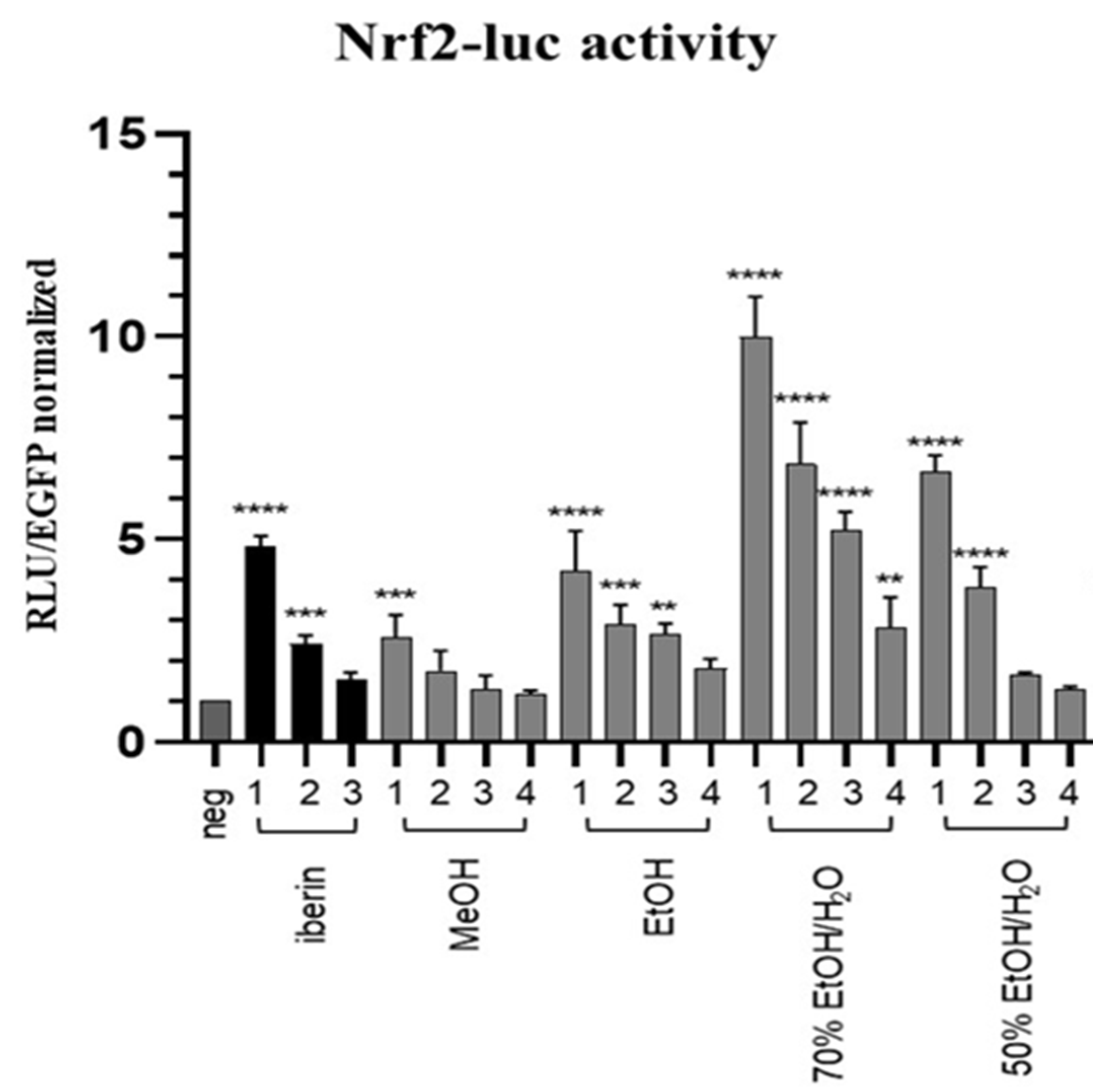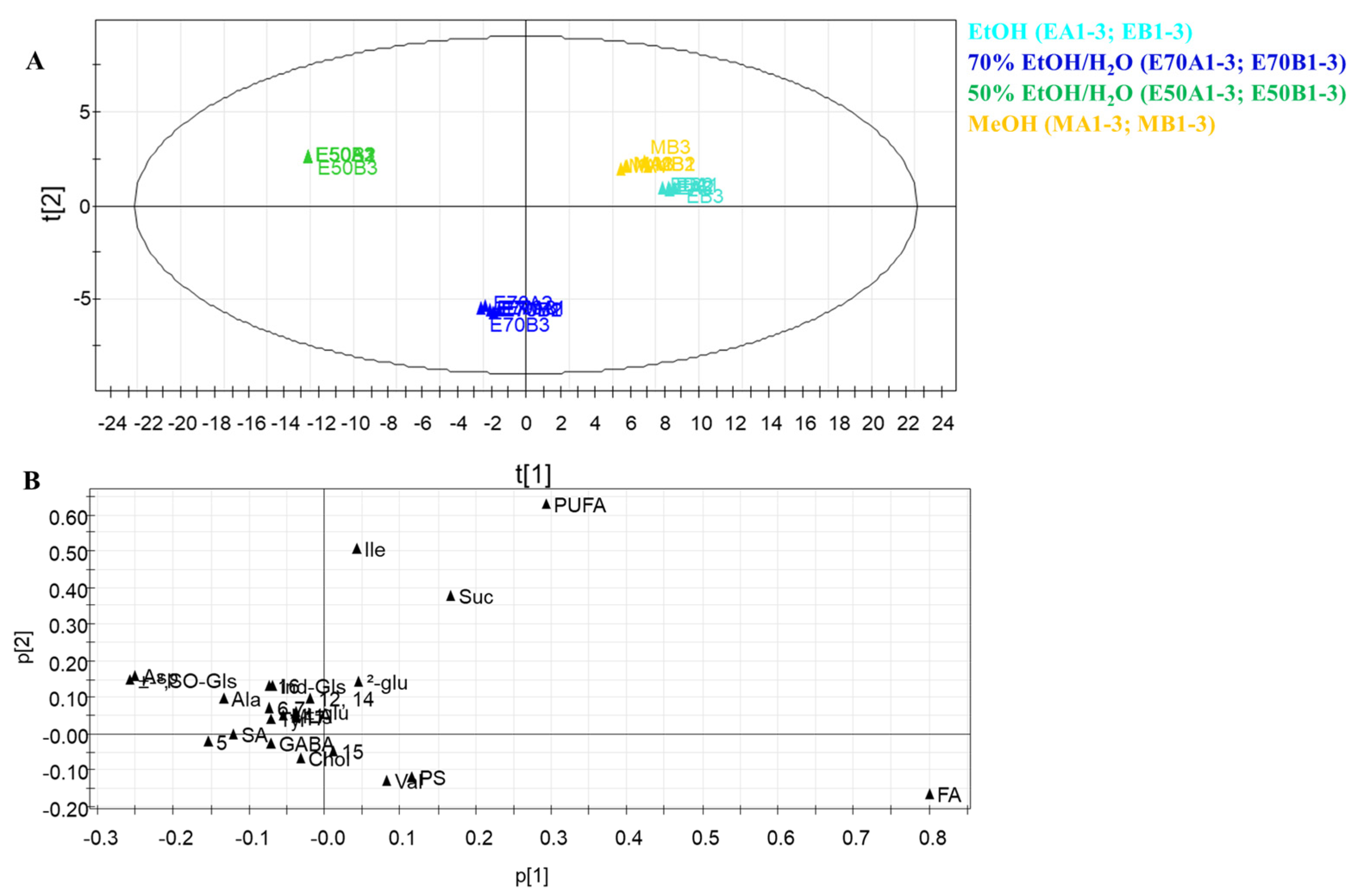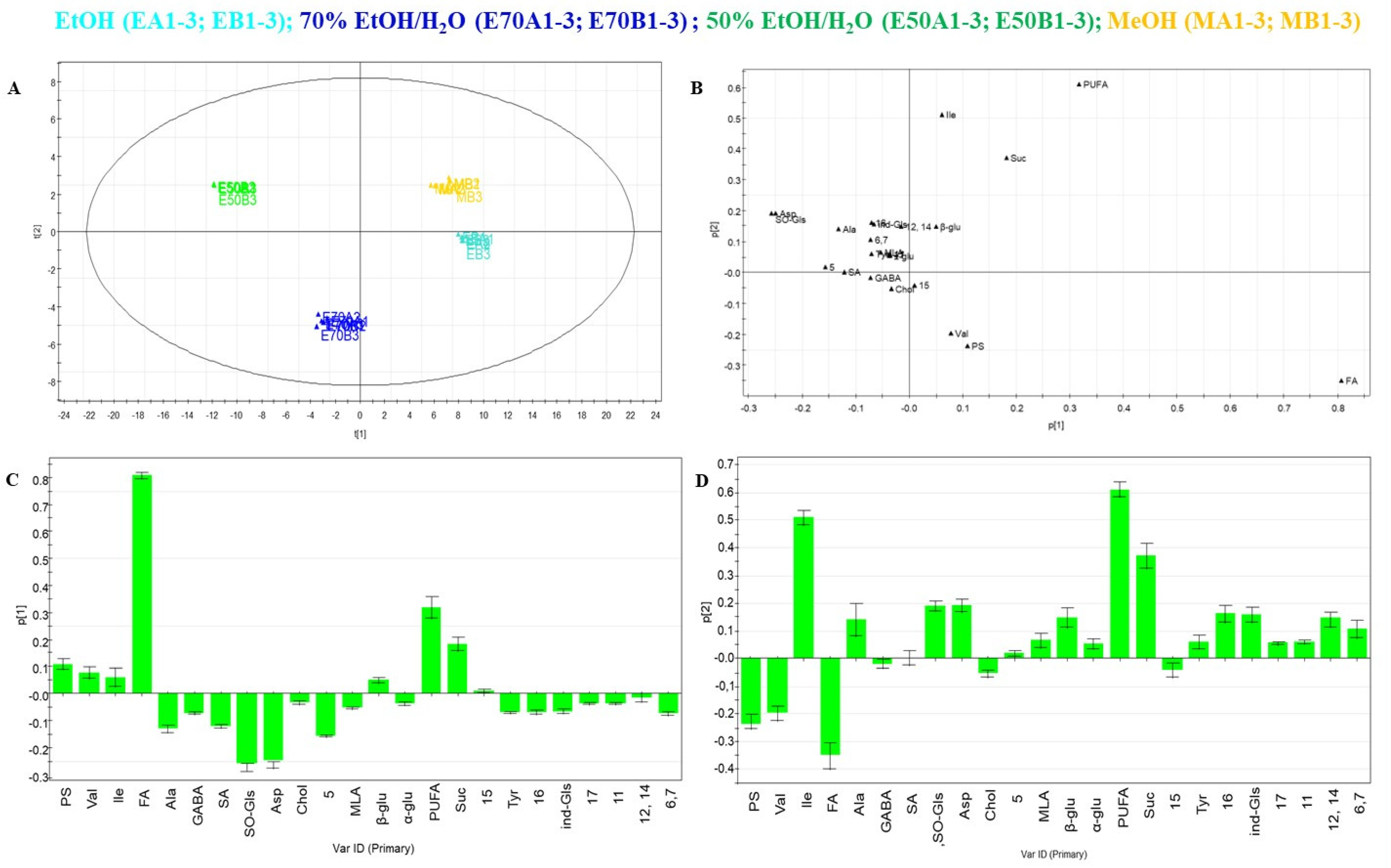LC-MS- and 1H NMR-Based Metabolomics to Highlight the Impact of Extraction Solvents on Chemical Profile and Antioxidant Activity of Daikon Sprouts (Raphanus sativus L.)
Abstract
1. Introduction
2. Materials and Methods
2.1. General Methods
2.2. Plant Material and Extraction
2.3. LC-HRMS Profiling
2.4. Isolation of Hydroxycinnamic Acid Derivatives
2.5. Determination of Total Phenolic Content
2.6. Determination of DPPH Radical Scavenging Activity and TEAC Radical Scavenging Activity
2.7. Activation of the Nrf2 Pathway Assessed by a Reporter Gene Assay
2.8. Statistical Analysis
2.9. 1H NMR Parameters and Data Processing for Multivariate Data Analysis
2.10. Multivariate Data Analysis (MVDA)
2.10.1. Principal Component Analysis
2.10.2. Partial Least Squares-Discriminant Analysis (PLS-DA)
3. Results and Discussion
3.1. LC-ESI/LTQOrbitrap/MS Profiling of R. sativus Sprouts
| tr | m/z | ppm | Molecular Formula | MS/MS | Compound | |
|---|---|---|---|---|---|---|
| 1 | 2.72 | 434.1692 | −0.64 | C12H21O10NS3 | 419, 354, 275, 259, 241, 195 | glucoraphenin 1 |
| 2 | 4.31 | 463.0468 | −1.95 | C16H20O10N2S2 | 301, 285, 267, 198 | hydroxyglucobrassicin 1 |
| 3 | 6.08 | 420.1303 | −1.26 | C12H23O9NS3 | 275, 259, 195 | glucoerucin 1 |
| 4 | 6.84 | 418.0292 | −0.40 | C12H21O9NS3 | 338, 275, 259, 241, 175 | glucoraphasatin 1 |
| 5 | 7.28 | 237.0758 | 0.41 | C12H14O5 | 237 | methylsinapate 2 |
| 6 | 7.98 | 385.1130 | 0.23 | C17H22O10 | 265, 247, 223, 205 | 1-O-sinapoyl-β-D-glucopyranoside 2 |
| 7 | 8.11 | 355.1024 | 0.11 | C16H20O9 | 217, 193, 175 | 1-O-feruloyl-β-D-glucopyranoside 2 |
| 8 | 9.53 | 477.0630 | −1.91 | C17H22O10N2S2 | 397, 299, 281, 315, 275, 259, 235, 195 | methoxyglucobrassicin 1 |
| 9 | 11.41 | 640.1726 | −1.08 | C23H31O14NS3 | 625, 465, 434, 325, 283, 223 | sinapoylglucoraphanin 1 |
| 10 | 11.53 | 538.0502 | −0.68 | C19H25O11NS3 | 523, 379, 376, 363, 282, 256, 241, 224, 201, 192, 169, 156, 136, 129, 121, 97 | benzoylglucoraphenin 1 |
| 11 | 12.94 | 223.0607 | 2.81 | C11H12O5 | 164 | sinapic acid 2 |
| 12 | 12.94 | 753.2516 | −2.01 | C34H42O19 | 547, 529, 365, 325, 223 | 3,6’-O-disinapoylsucrose 2 |
| 13 | 13.21 | 193.0502 | 2.51 | C10H10O4 | 149, 134 | ferulic acid 2 |
| 14 | 13.41 | 723.2121 | −1.37 | C33H40O18 | 547, 529, 517, 499, 337 | 3-O-feruloyl-6′-O-sinapoyl-sucrose 2 |
| 15 | 15.53 | 591.1705 | −0.62 | C28H32O14 | 385, 367, 352, 247, 223, 205 | 1,2-O-disinapoyl-β-D-glucopyranoside 2 |
| 16 | 16.26 | 561.1598 | −1.01 | C27H30O13 | 367, 337, 284, 223 | 1-O-feruloyl-2-O-sinapoyl-β-D-glucopyranoside 2 |
| 17 | 16.60 | 959.2794 | −0.91 | C45H52O23 | 753, 735, 529, 368 | 3,4,6′-O-Trisinapoylsucrose 2 |
| 18 | 20.01 | 327.2167 | 0.43 | C18H32O5 | 309, 291, 229, 211, 171 | 9,12,13-trihydroxyoctadeca-10-15-dienoic acid 1 |
| 19 | 21.48 | 329.2322 | 0.06 | C18H34O5 | 311, 299, 211, 171, 139, 127 | 9,12,13-trihydroxyoctadeca-10-enoic acid 1 |
3.2. Isolation and Characterization of Hydroxycinnamic Acid Derivatives in R. sativus Sprouts
3.3. Evaluation of the Antioxidant Activity of Different Extracts of Daikon Sprouts
3.4. Activation of the Nrf2 Pathway Assessed by a Reporter Gene Assay
3.5. Multivariate Data Analysis
3.5.1. Untargeted Metabolite Profiling of R. sativus var longipinnatus Extracts
3.5.2. Targeted Metabolite Profiling of R. sativus var longipinnatus Extracts
3.5.3. Partial Least Square Discriminant Analysis (PLS-DA)
4. Conclusions
Supplementary Materials
Author Contributions
Funding
Institutional Review Board Statement
Informed Consent Statement
Data Availability Statement
Conflicts of Interest
References
- Donato-Capel, L.; Garcia-Rodenas, C.L.; Pouteau, E.; Lehmann, U.; Srichuwong, S.; Erkner, A.; Kolodziejczyk, E.; Hughes, E.; Wooster, T.J.; Sagalowicz, L. Chapter 14—Technological Means to Modulate Food Digestion and Physiological Response. In Food Structures, Digestion and Health; Boland, M., Golding, M., Singh, H., Eds.; Academic Press: San Diego, CA, USA, 2014; pp. 389–422. [Google Scholar]
- Monde, K.; Takasugi, M.; Shirata, A. Three sulphur-containing stress metabolites from Japanese radish. Phytochemistry 1995, 39, 581–586. [Google Scholar] [CrossRef]
- Zappia, A.; Spanti, A.; Princi, R.; Imeneo, V.; Piscopo, A. Evaluation of the Efficacy of Antioxidant Extract from Lemon By-Products on Preservation of Quality Attributes of Minimally Processed Radish (Raphanus sativus L.). Antioxidants 2023, 12, 235. [Google Scholar] [CrossRef] [PubMed]
- Choe, U.; Yu, L.L.; Wang, T.T.Y. The Science behind Microgreens as an Exciting New Food for the 21st Century. J. Agric. Food Chem. 2018, 66, 11519–11530. [Google Scholar] [CrossRef] [PubMed]
- Turner, E.R.; Luo, Y.G.; Buchanan, R.L. Microgreen nutrition, food safety, and shelf life: A review. J. Food Sci. 2020, 85, 870–882. [Google Scholar] [CrossRef]
- Takaya, Y.; Kondo, Y.; Furukawa, T.; Niwa, M. Antioxidant Constituents of Radish Sprout (Kaiware-daikon), Raphanus sativus L. J. Agric. Food Chem. 2003, 51, 8061–8066. [Google Scholar] [CrossRef]
- Ippoushi, K.; Takeuchi, A.; Ito, H.; Horie, H.; Azuma, K. Antioxidative effects of daikon sprout (Raphanus sativus L.) and ginger (Zingiber officinale Roscoe) in rats. Food Chem. 2007, 102, 237–242. [Google Scholar] [CrossRef]
- Matera, R.; Gabbanini, S.; Berretti, S.; Amorati, R.; De Nicola, G.R.; Iori, R.; Valgimigli, L. Acylated anthocyanins from sprouts of Raphanus sativus cv. Sango: Isolation, structure elucidation and antioxidant activity. Food Chem. 2015, 166, 397–406. [Google Scholar] [CrossRef]
- Papi, A.; Orlandi, M.; Bartolini, G.; Barillari, J.; Iori, R.; Paolini, M.; Ferroni, F.; Grazia Fumo, M.; Pedulli, G.F.; Valgimigli, L. Cytotoxic and Antioxidant Activity of 4-Methylthio-3-butenyl Isothiocyanate from Raphanus sativus L. (Kaiware Daikon) Sprouts. J. Agric. Food Chem. 2008, 56, 875–883. [Google Scholar] [CrossRef]
- Boggia, R.; Zunin, P.; Turrini, F. Functional Foods and Food Supplements. Appl. Sci. 2020, 10, 8538. [Google Scholar] [CrossRef]
- Cerulli, A.; Masullo, M.; Montoro, P.; Hosek, J.; Pizza, C.; Piacente, S. Metabolite profiling of “green” extracts of Corylus avellana leaves by 1H NMR spectroscopy and multivariate statistical analysis. J. Pharm. Biomed. Anal. 2018, 160, 168–178. [Google Scholar] [CrossRef]
- Cerulli, A.; Masullo, M.; Pizza, C.; Piacente, S. Metabolite Profiling of “Green” Extracts of Cynara cardunculus subsp. scolymus, Cultivar “Carciofo di Paestum” PGI by 1H NMR and HRMS-Based Metabolomics. Molecules 2022, 27, 3328. [Google Scholar] [CrossRef] [PubMed]
- Niharika, P.; Arathi, K.; Grace, L.; Elisha, Y.; Babu, S.M. In vitro pharmacological study of extract of Raphanus sativus sprouts. Int. J. Res. Ayurveda Pharm. 2019, 10, 87–91. [Google Scholar] [CrossRef]
- Wu, S.; Liao, X.; Zhu, Z.; Huang, R.; Chen, M.; Huang, A.; Zhang, J.; Wu, Q.; Wang, J.; Ding, Y. Antioxidant and anti-inflammation effects of dietary phytochemicals: The Nrf2/NF-κB signalling pathway and upstream factors of Nrf2. Phytochemistry 2022, 204, 113429. [Google Scholar] [CrossRef]
- Itoh, K.; Chiba, T.; Takahashi, S.; Ishii, T.; Igarashi, K.; Katoh, Y.; Oyake, T.; Hayashi, N.; Satoh, K.; Hatayama, I.; et al. An Nrf2/small Maf heterodimer mediates the induction of phase II detoxifying enzyme genes through antioxidant response elements. Biochem. Biophys. Res. Commun. 1997, 236, 313–322. [Google Scholar] [CrossRef]
- Kolodziejczyk, J.; Masullo, M.; Olas, B.; Piacente, S.; Wachowicz, B. Effects of garcinol and guttiferone K isolated from Garcinia cambogia on oxidative/nitrative modifications in blood platelets and plasma. Platelets 2009, 20, 487–492. [Google Scholar] [CrossRef] [PubMed]
- Venugopal, R.; Jaiswal, A.K. Nrf1 and Nrf2 positively and c-Fos and Fra1 negatively regulate the human antioxidant response element-mediated expression of NAD(P)H:quinone oxidoreductase1 gene. Proc. Natl. Acad. Sci. USA 1996, 93, 14960–14965. [Google Scholar] [CrossRef] [PubMed]
- Masullo, M.; Cerulli, A.; Pizza, C.; Piacente, S. Pouteria lucuma Pulp and Skin: In Depth Chemical Profile and Evaluation of Antioxidant Activity. Molecules 2021, 26, 5236. [Google Scholar] [CrossRef]
- Cerulli, A.; Napolitano, A.; Masullo, M.; Hosek, J.; Pizza, C.; Piacente, S. Chestnut shells (Italian cultivar “Marrone di Roccadaspide” PGI): Antioxidant activity and chemical investigation with in depth LC-HRMS/MSn rationalization of tannins. Food Res. Int. 2020, 129, 108787. [Google Scholar] [CrossRef]
- Santos, C.C.D.; Masullo, M.; Cerulli, A.; Mari, A.; Estevam, C.D.; Pizza, C.; Piacente, S. Isolation of antioxidant phenolics from Schinopsis brasiliensis based on a preliminary LC-MS profiling. Phytochemistry 2017, 140, 45–51. [Google Scholar] [CrossRef]
- Bottone, A.; Montoro, P.; Masullo, M.; Pizza, C.; Piacente, S. Metabolomics and antioxidant activity of the leaves of Prunus dulcis Mill. (Italian cvs. Toritto and Avola). J. Pharm. Biomed. Anal. 2018, 160, 54–65. [Google Scholar] [CrossRef]
- Masullo, M.; Cerulli, A.; Mari, A.; de Souza Santos, C.C.; Pizza, C.; Piacente, S. LC-MS profiling highlights hazelnut (Nocciola di Giffoni PGI) shells as a byproduct rich in antioxidant phenolics. Food Res. Int. 2017, 101, 180–187. [Google Scholar] [CrossRef] [PubMed]
- Cannavacciuolo, C.; Napolitano, A.; Heiss, E.H.; Dirsch, V.M.; Piacente, S. Portulaca oleracea, a rich source of polar lipids: Chemical profile by LC-ESI/LTQOrbitrap/MS/MSn and in vitro preliminary anti-inflammatory activity. Food Chem. 2022, 388, 132968. [Google Scholar] [CrossRef] [PubMed]
- Cerulli, A.; Masullo, M.; Piacente, S. Metabolite Profiling of Helichrysum italicum Derived Food Supplements by 1H-NMR-Based Metabolomics. Molecules 2021, 26, 6619. [Google Scholar] [CrossRef] [PubMed]
- Barillari, J.; Cervellati, R.; Paolini, M.; Tatibouet, A.; Rollin, P.; Iori, R. Isolation of 4-Methylthio-3-butenyl Glucosinolate from Raphanus sativus Sprouts (Kaiware Daikon) and Its Redox Properties. J. Agric. Food Chem. 2005, 53, 9890–9896. [Google Scholar] [CrossRef] [PubMed]
- Fahey, J.W.; Zalcmann, A.T.; Talalay, P. The chemical diversity and distribution of glucosinolates and isothiocyanates among plants. Phytochemistry 2001, 56, 5–51. [Google Scholar] [CrossRef]
- Clarke, D.B. Glucosinolates, structures and analysis in food. Anal. Methods 2010, 2, 310–325. [Google Scholar] [CrossRef]
- Shi, H.; Zhao, Y.; Sun, J.; Yu, L.; Chen, P. Chemical profiling of glucosinolates in cruciferous vegetables-based dietary supplements using ultra-high performance liquid chromatography coupled to tandem high resolution mass spectrometry. J. Food Compos. Anal. 2017, 61, 67–72. [Google Scholar] [CrossRef]
- Shakeri, A.; Masullo, M.; D’Urso, G.; Iranshahi, M.; Montoro, P.; Pizza, C.; Piacente, S. In depth chemical investigation of Glycyrrhiza triphylla Fisch roots guided by a preliminary HPLC-ESIMSn profiling. Food Chem. 2018, 248, 128–136. [Google Scholar] [CrossRef]
- Napolitano, A.; Cerulli, A.; Pizza, C.; Piacente, S. Multi-class polar lipid profiling in fresh and roasted hazelnut (Corylus avellana cultivar “Tonda di Giffoni”) by LC-ESI/LTQOrbitrap/MS/MSn. Food Chem. 2018, 269, 125–135. [Google Scholar] [CrossRef]
- Connolly, E.L.; Sim, M.; Travica, N.; Marx, W.; Beasy, G.; Lynch, G.S.; Bondonno, C.P.; Lewis, J.R.; Hodgson, J.M.; Blekkenhorst, L.C. Glucosinolates from Cruciferous Vegetables and Their Potential Role in Chronic Disease: Investigating the Preclinical and Clinical Evidence. Front. Pharmacol. 2021, 12, 767975. [Google Scholar] [CrossRef]
- Cujic, N.; Savikin, K.; Jankovic, T.; Pljevljakusic, D.; Zdunic, G.; Ibric, S. Optimization of polyphenols extraction from dried chokeberry using maceration as traditional technique. Food Chem. 2016, 194, 135–142. [Google Scholar] [CrossRef] [PubMed]
- Carbone, K.; Macchioni, V.; Petrella, G.; Cicero, D.O. Exploring the potential of microwaves and ultrasounds in the green extraction of bioactive compounds from Humulus lupulus for the food and pharmaceutical industry. Ind. Crops Prod. 2020, 156, 112888. [Google Scholar] [CrossRef]




| 16 | ||
|---|---|---|
| δC | δH (J in Hz) | |
| glucose | ||
| 1 | 94.0 | 5.83 (d, 8.0) |
| 2 | 74.3 | 5.10 (dd, 8.0, 9.0) |
| 3 | 76.8 | 3.74 (dd, 9.0, 9.0) |
| 4 | 71.2 | 3.54 (dd, 9.0; 9.0) |
| 5 | 79.2 | 3.55 (m) |
| 6 | 62.2 | 3.93 (dd, 12.0, 2.5) |
| 3.77 (dd, 12.0, 4.5) | ||
| 1-O-feruloyl moiety | ||
| 1′ | 127.9 | |
| 2′ | 111.7 | 7.20 (d, 1.9) |
| 3′ | 150.3 | |
| 4′ | 147.6 | |
| 5′ | 116.8 | 6.82 (d, 8.3) |
| 6′ | 124.7 | 7.09 (dd,1.9; 8.3) |
| 7′ | 149.4 | 7.69 (d, 15.8) |
| 8′ | 116.3 | 6.31 (d, 15.8) |
| 9′ | 166.8 | |
| OCH3 | 56.8 | 3.90 s |
| 2-O-sinapoyl moiety | ||
| 1″ | 126.2 | |
| 2″ | 106.9 | 6.89 s |
| 3″ | 148.9 | |
| 4″ | 139.1 | |
| 5″ | 148.9 | |
| 6″ | 106.9 | 6.89 s |
| 7″ | 148.5 | 7.64 (d, 15.8) |
| 8″ | 115.5 | 6.43 (d, 15.8) |
| 9″ | 167.1 | |
| OCH3 | 56.7 | 3.87 s |
Disclaimer/Publisher’s Note: The statements, opinions and data contained in all publications are solely those of the individual author(s) and contributor(s) and not of MDPI and/or the editor(s). MDPI and/or the editor(s) disclaim responsibility for any injury to people or property resulting from any ideas, methods, instructions or products referred to in the content. |
© 2023 by the authors. Licensee MDPI, Basel, Switzerland. This article is an open access article distributed under the terms and conditions of the Creative Commons Attribution (CC BY) license (https://creativecommons.org/licenses/by/4.0/).
Share and Cite
Cannavacciuolo, C.; Cerulli, A.; Dirsch, V.M.; Heiss, E.H.; Masullo, M.; Piacente, S. LC-MS- and 1H NMR-Based Metabolomics to Highlight the Impact of Extraction Solvents on Chemical Profile and Antioxidant Activity of Daikon Sprouts (Raphanus sativus L.). Antioxidants 2023, 12, 1542. https://doi.org/10.3390/antiox12081542
Cannavacciuolo C, Cerulli A, Dirsch VM, Heiss EH, Masullo M, Piacente S. LC-MS- and 1H NMR-Based Metabolomics to Highlight the Impact of Extraction Solvents on Chemical Profile and Antioxidant Activity of Daikon Sprouts (Raphanus sativus L.). Antioxidants. 2023; 12(8):1542. https://doi.org/10.3390/antiox12081542
Chicago/Turabian StyleCannavacciuolo, Ciro, Antonietta Cerulli, Verena M. Dirsch, Elke H. Heiss, Milena Masullo, and Sonia Piacente. 2023. "LC-MS- and 1H NMR-Based Metabolomics to Highlight the Impact of Extraction Solvents on Chemical Profile and Antioxidant Activity of Daikon Sprouts (Raphanus sativus L.)" Antioxidants 12, no. 8: 1542. https://doi.org/10.3390/antiox12081542
APA StyleCannavacciuolo, C., Cerulli, A., Dirsch, V. M., Heiss, E. H., Masullo, M., & Piacente, S. (2023). LC-MS- and 1H NMR-Based Metabolomics to Highlight the Impact of Extraction Solvents on Chemical Profile and Antioxidant Activity of Daikon Sprouts (Raphanus sativus L.). Antioxidants, 12(8), 1542. https://doi.org/10.3390/antiox12081542







